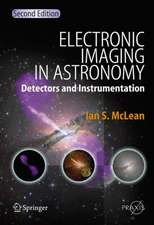The Epoch of Galaxy Formation: Nato Science Series C:, cartea 264
Editat de Carlos S. Frenk, Richard S. Ellis, T. Shanks, Alan F. Heavens, John A. Peacocken Limba Engleză Paperback – oct 2011
Din seria Nato Science Series C:
- 24%
 Preț: 797.66 lei
Preț: 797.66 lei - 18%
 Preț: 957.62 lei
Preț: 957.62 lei - 18%
 Preț: 957.13 lei
Preț: 957.13 lei - 18%
 Preț: 1227.52 lei
Preț: 1227.52 lei -
 Preț: 396.40 lei
Preț: 396.40 lei -
 Preț: 403.75 lei
Preț: 403.75 lei - 18%
 Preț: 1239.37 lei
Preț: 1239.37 lei - 18%
 Preț: 1236.51 lei
Preț: 1236.51 lei - 18%
 Preț: 1231.78 lei
Preț: 1231.78 lei - 18%
 Preț: 1229.10 lei
Preț: 1229.10 lei - 18%
 Preț: 1835.21 lei
Preț: 1835.21 lei - 24%
 Preț: 1076.36 lei
Preț: 1076.36 lei -
 Preț: 390.46 lei
Preț: 390.46 lei -
 Preț: 369.63 lei
Preț: 369.63 lei - 18%
 Preț: 1232.41 lei
Preț: 1232.41 lei -
 Preț: 394.51 lei
Preț: 394.51 lei - 18%
 Preț: 1226.24 lei
Preț: 1226.24 lei - 18%
 Preț: 1845.80 lei
Preț: 1845.80 lei -
 Preț: 399.88 lei
Preț: 399.88 lei -
 Preț: 384.28 lei
Preț: 384.28 lei -
 Preț: 390.88 lei
Preț: 390.88 lei -
 Preț: 381.19 lei
Preț: 381.19 lei - 18%
 Preț: 1848.64 lei
Preț: 1848.64 lei - 18%
 Preț: 951.14 lei
Preț: 951.14 lei - 18%
 Preț: 1230.35 lei
Preț: 1230.35 lei - 18%
 Preț: 1236.51 lei
Preț: 1236.51 lei -
 Preț: 401.03 lei
Preț: 401.03 lei -
 Preț: 406.25 lei
Preț: 406.25 lei - 18%
 Preț: 1230.84 lei
Preț: 1230.84 lei -
 Preț: 418.34 lei
Preț: 418.34 lei - 18%
 Preț: 1223.74 lei
Preț: 1223.74 lei
Preț: 398.53 lei
Nou
Puncte Express: 598
Preț estimativ în valută:
76.28€ • 79.33$ • 63.92£
76.28€ • 79.33$ • 63.92£
Carte tipărită la comandă
Livrare economică 13-27 martie
Preluare comenzi: 021 569.72.76
Specificații
ISBN-13: 9789401069021
ISBN-10: 9401069026
Pagini: 476
Ilustrații: 470 p.
Dimensiuni: 155 x 235 x 25 mm
Greutate: 0.66 kg
Ediția:Softcover reprint of the original 1st ed. 1989
Editura: SPRINGER NETHERLANDS
Colecția Springer
Seria Nato Science Series C:
Locul publicării:Dordrecht, Netherlands
ISBN-10: 9401069026
Pagini: 476
Ilustrații: 470 p.
Dimensiuni: 155 x 235 x 25 mm
Greutate: 0.66 kg
Ediția:Softcover reprint of the original 1st ed. 1989
Editura: SPRINGER NETHERLANDS
Colecția Springer
Seria Nato Science Series C:
Locul publicării:Dordrecht, Netherlands
Public țintă
ResearchCuprins
I. Forming Galaxies.- Galaxy formation: high redshift or low?.- Observable signatures of young galaxies.- A multicolor search for forming galaxies.- Lyman-alpha galaxies in 1988.- Morphological evolution of radio galaxies.- High redshift radio galaxies and galaxy formation.- Deep surveys of field and low-flux-radio galaxies.- Constraints on the epoch of galaxy formation from deep U-band counts.- II. Gas Clouds.- Lyman line absorption systems.- Damped Lyman alpha absorbers: the progenitors of galactic disks.- A chemically young galaxy at z=2.3.- Lyman ? emission from a possible primeval galaxy at z=2.5.- III. Quasars.- The quasar redshift cut-off.- Fifty-three multicolour selected quasars with redshifts greater than three.- The luminosity function and clustering of QSOs.- High redshift quasars in the cold dark matter cosmology.- The intergalactic medium and the epoch of galaxy formation.- A cooling flow around the quasar 3C196.- IV. Evolution of Galaxies and Clusters.- Galaxy evolution in high density environments.- Evolution of compact groups and formation of elliptical.- Properties of galaxy clusters associated with quasars.- History of star formation in normal galaxies.- Recurrent star formation in elliptical galaxies.- V. Background Radiation.- Constraints on galaxy formation from cosmic background radiations.- Explaining the Nagoya-Berkeley submillimetre background.- Star formation and the x-ray background.- VI. Models.- Galaxy formation and biased clustering.- Galaxy clusters and the epoch of galaxy formation.- Exploring origins for the Hubble sequence.- Galaxy mergers in a CDM model.- Clustering and dynamics in a dissipative CDM N-body simulation.- The galaxy luminosity function: an alternative to the Press and Schechter technique.- Galactic evolution and globalstar formation.- Galaxy formation and cooling flows.- The epoch of galaxy formation in explosion models.- Recent results on cosmic strings and galaxy formation.- Galaxy formation in unstable dark matter models.- VII. The Age of the Galaxy.- The age of the Galaxy.- The nature and age of the galactic thick disk.- A simple model for the Local Group of Galaxies.- VIII. Prospects.- Future observational prospects.- Poster Papers.- A new deep AAT redshift survey.- On the interpretation of galaxy counts, and color and redshift distributions.- The interpretation of faint galaxy counts.- Limits on dust in damped Lyman-alpha systems and the obscuration of quasars.- The stellar content of early-type galaxies in dense environments.- A new study of absorption line density in QSO’s Ly? forest.- The Edinburgh/Durham southern galaxy catalogue.- Mass-to-light ratios and the age of galaxies.- Emission lines and star formation in radio galaxies.- The age of the radiogalaxy 0902+34 at the redshift z=3.395.- Statistics of radio galaxy populations and galaxy formation.- Simulations of the visual appearance of galaxy clusters at high redshift.- Central galaxy formation by cooling flows.- Constraints on the amplitude of primordial density fluctuations.- Spottiness in the structure of the microwave background radiation.- Energetic constraints on spectral distortions of the microwave background.- CBR polarization by cosmic dust at high redshifts.- Growth of perturbations in a collapsing protogalaxy.- The turnaround epoch of clusters of galaxies.- The correlations of peaks in random noise.- Density maxima as sites for galaxy formation.- A cross-correlation method to test the dependence of the clustering of galaxies on luminosity.- Constraints on the formation redshift of bright galaxies inbiased scenarios.- Biased theories with non-v threshold.- Sinking satellites and disk heating of spiral galaxies.- Galaxy formation in asymmetric dark haloes.- Gas in a cosmological N-body simulation.- Dissipational galaxy formation.- Tidal origin of starbursts and active galactic nuclei.- The topology of large scale structure: observations.- Append.- Galaxy formation: the board game.- Author Index.

























